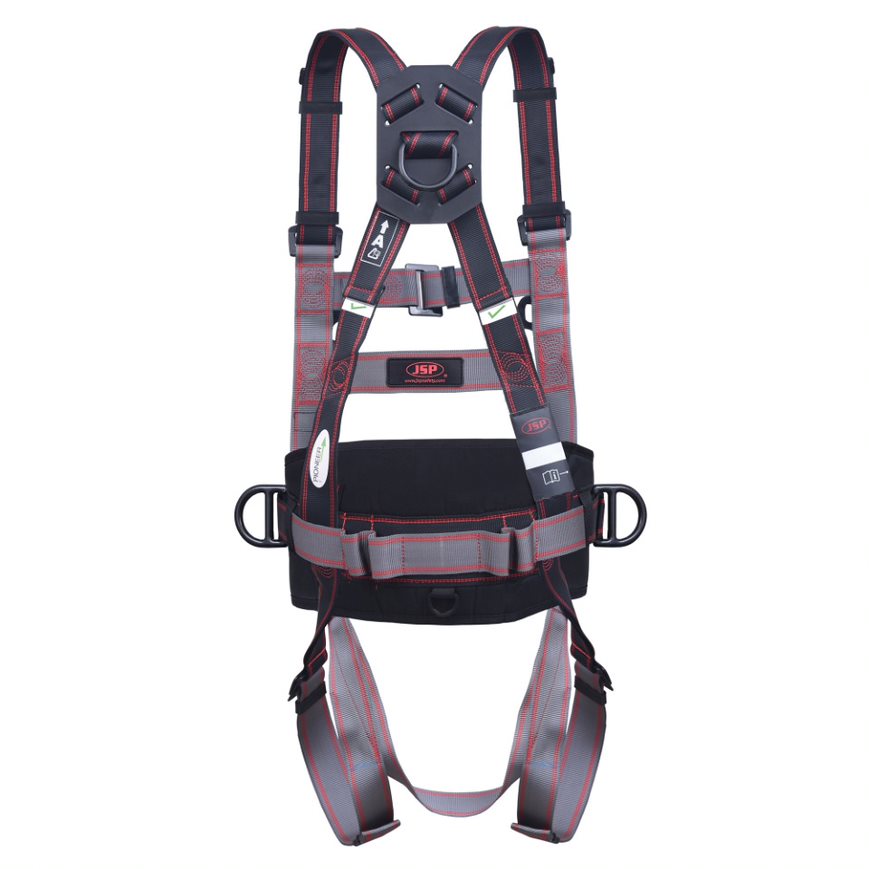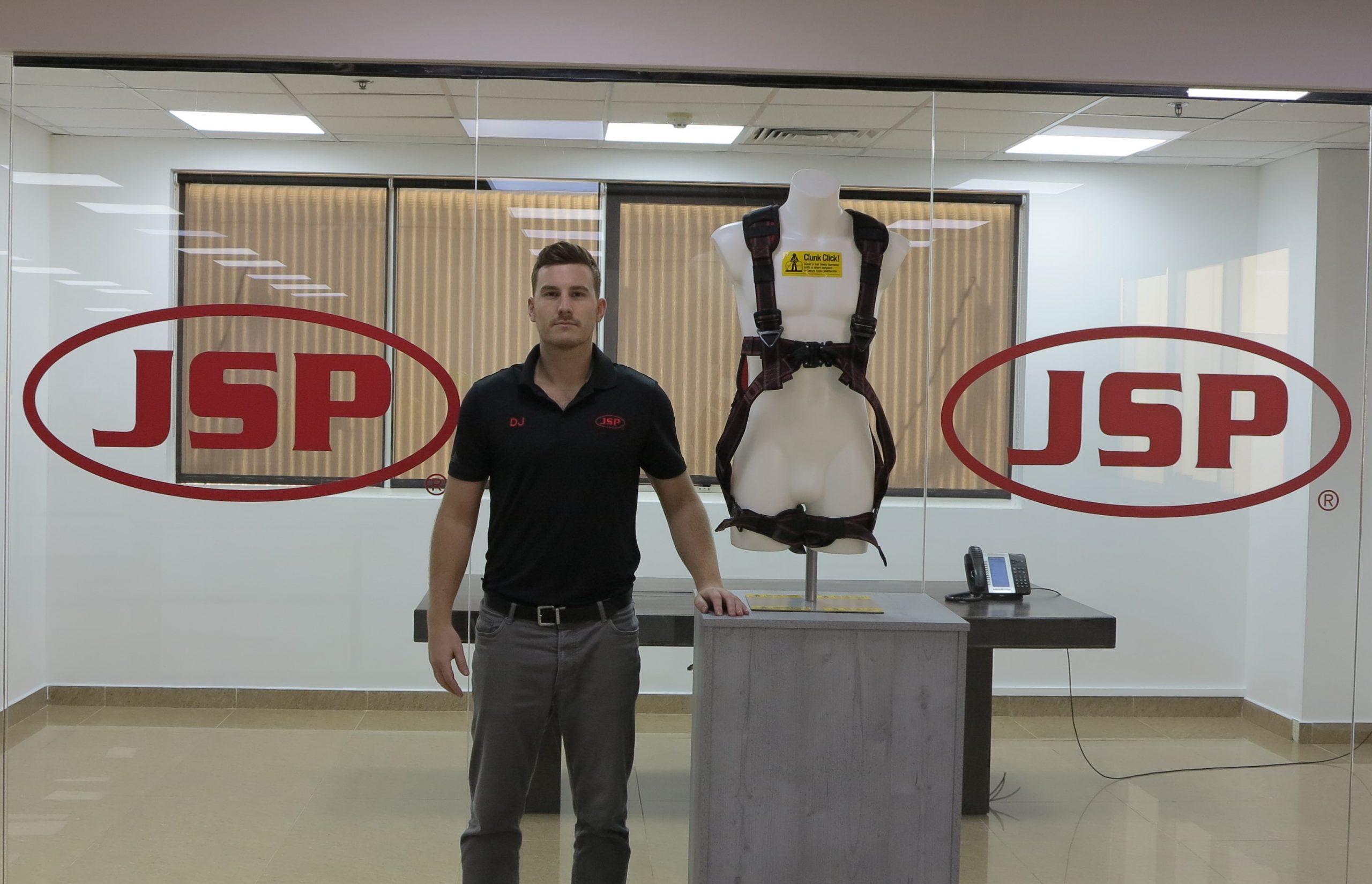JSP Full Body Harnesses
There are many different types of height safety equipment on the market, which can mean choosing a harness and connecting device quickly becomes confusing. The following provides some guidance
on what to think about when selecting PFPE.

Full Body Harnesses
Full-body harnesses are designed to work with both fall arrest and restraint devices and must conform, as a minimum, to the EN361 standard. With a wide range available on the market, varying
in appearance and price point, choice of harness style is ultimately determined by the level of comfort provided. Comfort factors are affected by materials and parts of the harness – such as
webbing type, adjustment system, and type of buckles. However, the most important considerations when selecting a harness are the number of attachment points, user limit, and lifespan of the
product. Full body harness attachment points vary, ranging from 1-point to 5-point, which are generally positioned as below:
- 1-Point – one attachment point at the back of the harness
- 2-Point – attachment points on both the front and back of the harness
- 3- / 4-Point – front and back attachment points, and a work positioning belt
- 5-Point – front and back attachment points, a work positioning belt, and a lower front point for abseil/rope access
When selecting your harness it is important to think about where the lanyard will be positioned when you are working, and how it will connect to the harness – for example, if you will only be
working with the lanyard positioned behind you then a 1-point harness will be sufficient, whereas if you will also need to work with the lanyard positioned to your front then you will instead need a harness with 2 or more attachment points.

Fall Arrest vs Restraint
When selecting your anchoring device, it is important to determine whether you can work in restraint, or if you will be working in fall arrest. Other key factors to consider are the required length of the device and, if working in fall arrest, the potential fall distance.
Restraint and fall arrest equipment provide fall protection in different ways:
- Restraint systems prevent a fall from occurring – the device works so you cannot go over the edge, removing the risk of a fall altogether.
- Fall arrest systems are used where the risk of a fall cannot be removed, and if a fall were to occur the equipment is activated to arrest the fall within a safe distance and reduce the
dynamic energy to below 6kN.
Working in restraint is safer and should always be your first choice, providing the application of work allows it. Restraint lanyards can be fixed or adjustable and are available in several lengths. I would suggest selecting adjustable restraint lanyards wherever possible – these are the more practical option, enabling you to work in multiple different work scenarios where the falling edge is at varying distances.
For fall arrest systems, the most commonly used device is the fall arrest lanyard (EN355) – this type of lanyard features a shock-absorbing pack, which ensures the force of the fall remains below a maximum limit deemed safe for the user. Shock absorption packs contain a length of webbing (usually around 1.75m) folded and stitched together. When a fall occurs, the resulting force on the lanyard deploys the pack and releases the length of webbing; the stitching is torn as the user falls, which disperses the force of the fall to below 6kN.
When calculating the length of lanyard appropriate for a certain job, the total length of the deployed lanyard must be accounted for – if the length of the lanyard, or ‘relaxed length’, is 2m, then the ‘extended length’ of the lanyard, once deployed, could be up to 3.75m. This means when added together with user height (2m), and the 1m free space required for all work at height, there should be at least 6.75m free space beneath the operative for the lanyard to work safely. The most common mistake made by users of fall arrest lanyards is failing to properly account for the length of the deployed shock absorption pack meaning, in the event of a fall, the user would reach the ground before the lanyard can safely arrest the fall.
Where it is not possible to work at a height of 6.75m or above, several alternative devices can be used, such as fall arrest blocks (EN360) and vertical rope and grab systems (tested to EN353-2). A fall arrest block works similarly to a vehicle seat belt – the user can move around freely, but sudden force caused by a slip or fall causes the device to instantly lock off, which will safely arrest the user within 1m. Rope and grab systems use the same principle in a vertical direction, allowing users to move up and down the rope, and in the event of a slip or fall the rope grab locks on the rope, again arresting the fall safely within 1m.
Anchorages / Connectors
Lanyards are available with a variety of connector options, and your selection should be based on the type of anchor point available and its position. In some cases, a karabiner or scaffold hook alone may not be sufficient, and you may need to consider an additional anchorage sling or temporary horizontal lifeline.
Karabiners on the market offer a range of locking mechanisms, which can be manual or automatic. Unlocking mechanisms also vary – with screw gate (manual), double-action (auto), and triple action (auto) options. The choice of unlocking mechanism is based on user preference, though the triple action lock is considered safest as it takes three deliberate movements to unlock, meaning there is minimal chance of the karabiner unlocking unintentionally, and the mechanism also locks automatically. Karabiner materials are generally aluminum or steel. Material choice is determined by user preference – aluminum is a popular option due to its lightweight, however, steel can be stronger and more hard-wearing.
